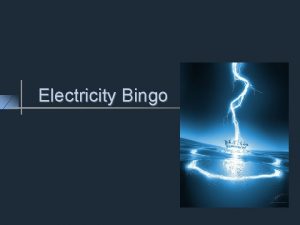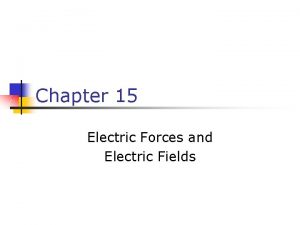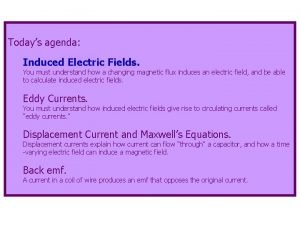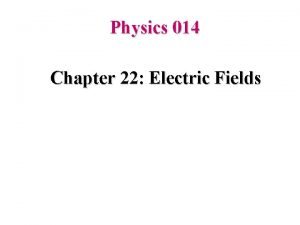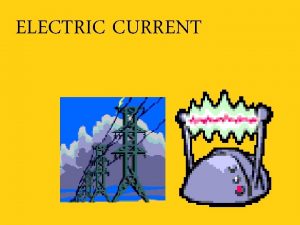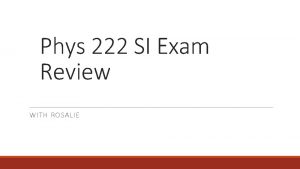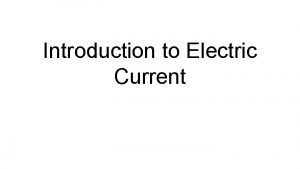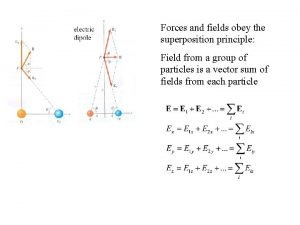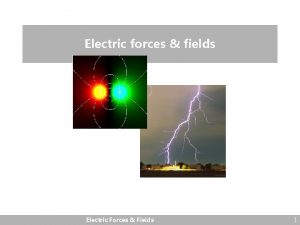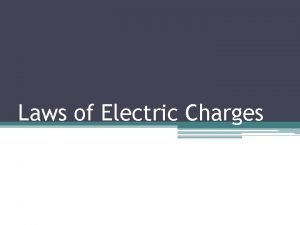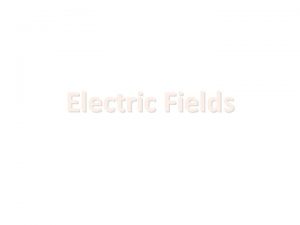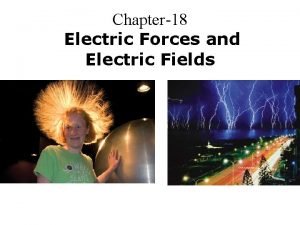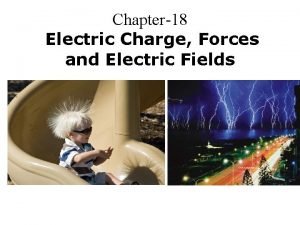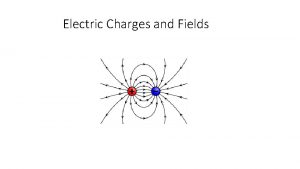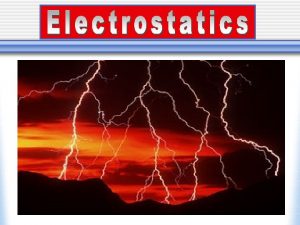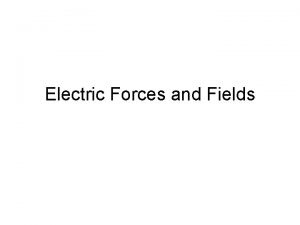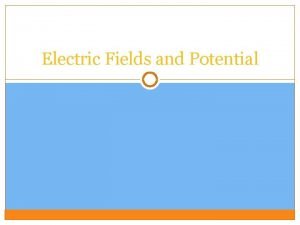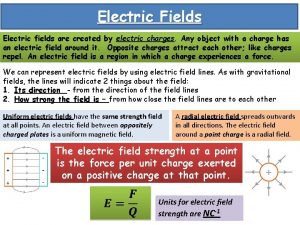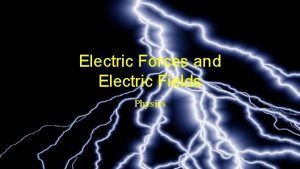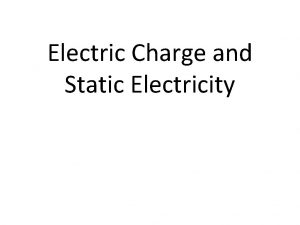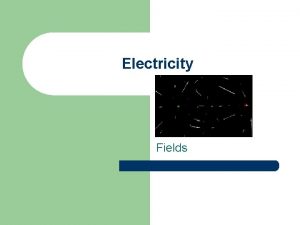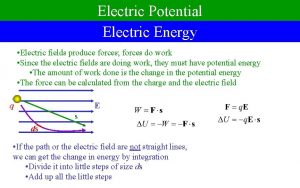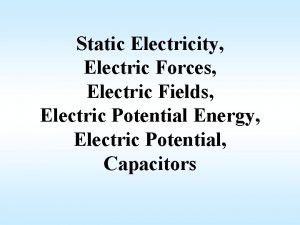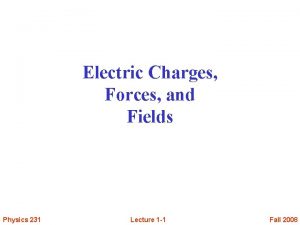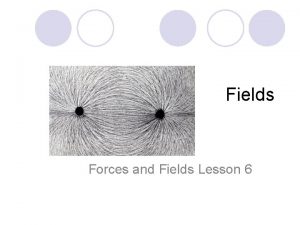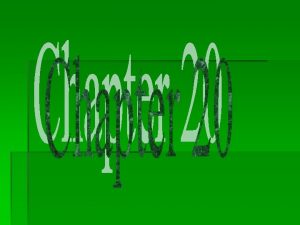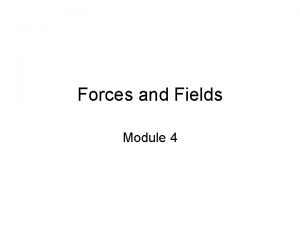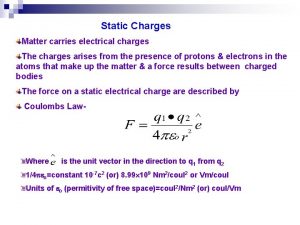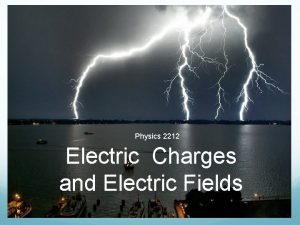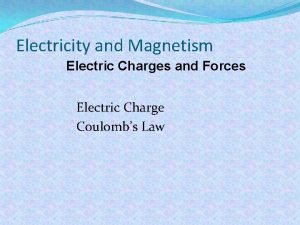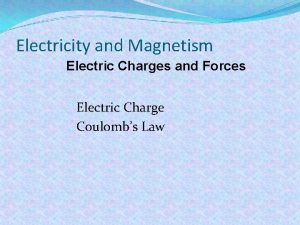Electric Charges Forces and Fields Electric Charge The
























- Slides: 24

Electric Charges, Forces, and Fields

Electric Charge The effects of electric charge were first observed as static electricity: After being rubbed on a piece of fur, an amber rod acquires a charge and can attract small objects.

Electric Charge Charging both amber and glass rods shows that there are two types of electric charge; like charges repel and opposites attract.

Electric Charge All electrons have exactly the same charge; the charge on the proton (in the atomic nucleus) has the same magnitude but the opposite sign:

Electric Charge The electrons in an atom are in a cloud surrounding the nucleus, and can be separated from the atom with relative ease.

Electric Charge When an amber rod is rubbed with fur, some of the electrons on the atoms in the fur are transferred to the amber:

Electric Charge We find that the total electric charge of the universe is a constant: Electric charge is conserved. Also, electric charge is quantized in units of e. The atom that has lost an electron is now positively charged – it is a positive ion The atom that has gained an electron is now negatively charged – it is a negative ion

Electric Charge Some materials can become polarized – this means that their atoms rotate in response to an external charge. This is how a charged object can attract a neutral one.

Insulators and Conductors Conductor: A material whose conduction electrons are free to move throughout. Most metals are conductors. Insulator: A material whose electrons seldom move from atom to atom. Most insulators are non-metals.

Insulators and Conductors If a conductor carries excess charge, the excess is distributed over the surface of the conductor.

Insulators and Conductors Semiconductors have properties intermediate between conductors and insulators; their properties change with their chemical composition. Photoconductive materials become conductors when light shines on them.

The Electric Field Definition of the electric field: Here, q 0 is a “test charge” – it serves to allow the electric force to be measured, but is not large enough to create a significant force on any other charges.

The Electric Field If we know the electric field, we can calculate the force on any charge: The direction of the force depends on the sign of the charge – in the direction of the field for a positive charge, opposite to it for a negative one.

The Electric Field The electric field of a point charge points radially away from a positive charge and towards a negative one.

The Electric Field Just as electric forces can be superposed, electric fields can as well.

Electric Field Lines Electric field lines are a convenient way of visualizing the electric field. Electric field lines: 1. Point in the direction of the field vector at every point 2. Start at positive charges or infinity 3. End at negative charges or infinity 4. Are more dense where the field is stronger

Electric Field Lines The charge on the right is twice the magnitude of the charge on the left (and opposite in sign), so there are twice as many field lines, and they point towards the charge rather than away from it.

Electric Field Lines Combinations of charges. Note that, while the lines are less dense where the field is weaker, the field is not necessarily zero where there are no lines. In fact, there is only one point within the figures below where the field is zero – can you find it?

Electric Field Lines A parallel-plate capacitor consists of two conducting plates with equal and opposite charges. Here is the electric field:

Shielding and Charge by Induction Since excess charge on a conductor is free to move, the charges will move so that they are as far apart as possible. This means that excess charge on a conductor resides on its surface, as in the upper diagram.

Shielding and Charge by Induction When electric charges are at rest, the electric field within a conductor is zero.

Shielding and Charge by Induction The electric field is always perpendicular to the surface of a conductor – if it weren’t, the charges would move along the surface.

Shielding and Charge by Induction The electric field is stronger where the surface is more sharply curved.

Shielding and Charge by Induction A conductor can be charged by induction, if there is a way to ground it. This allows the like charges to leave the conductor; if the conductor is then isolated before the rod is removed, only the excess charge remains.
 Electric charges and electric forces lesson outline
Electric charges and electric forces lesson outline Electric forces and fields concept review
Electric forces and fields concept review Chapter 16: electric forces and fields answers
Chapter 16: electric forces and fields answers Like charges blank and opposite charges blank
Like charges blank and opposite charges blank Difference between charge and electric charge
Difference between charge and electric charge Difference between charge and electric charge
Difference between charge and electric charge Red fields
Red fields Chapter 21 electric charge and electric field
Chapter 21 electric charge and electric field Chapter 21 electric charge and electric field
Chapter 21 electric charge and electric field Chapter 16 electric charge and electric field
Chapter 16 electric charge and electric field Chapter 21 electric charge and electric field
Chapter 21 electric charge and electric field Learning: module 26: magnetic forces and fields
Learning: module 26: magnetic forces and fields Conceptual physics chapter 33
Conceptual physics chapter 33 Electric currents and magnetic fields
Electric currents and magnetic fields Electric currents and magnetic fields
Electric currents and magnetic fields Electric fields quiz
Electric fields quiz Electric fields
Electric fields Electric fields
Electric fields Induced electric field
Induced electric field Physics chapter 21 study guide answers
Physics chapter 21 study guide answers Chapter 22 electric fields
Chapter 22 electric fields The net movement of electric
The net movement of electric The figure shows three electric charges labeled
The figure shows three electric charges labeled Continuous flow of electric charges
Continuous flow of electric charges Superposition principle electric field
Superposition principle electric field



